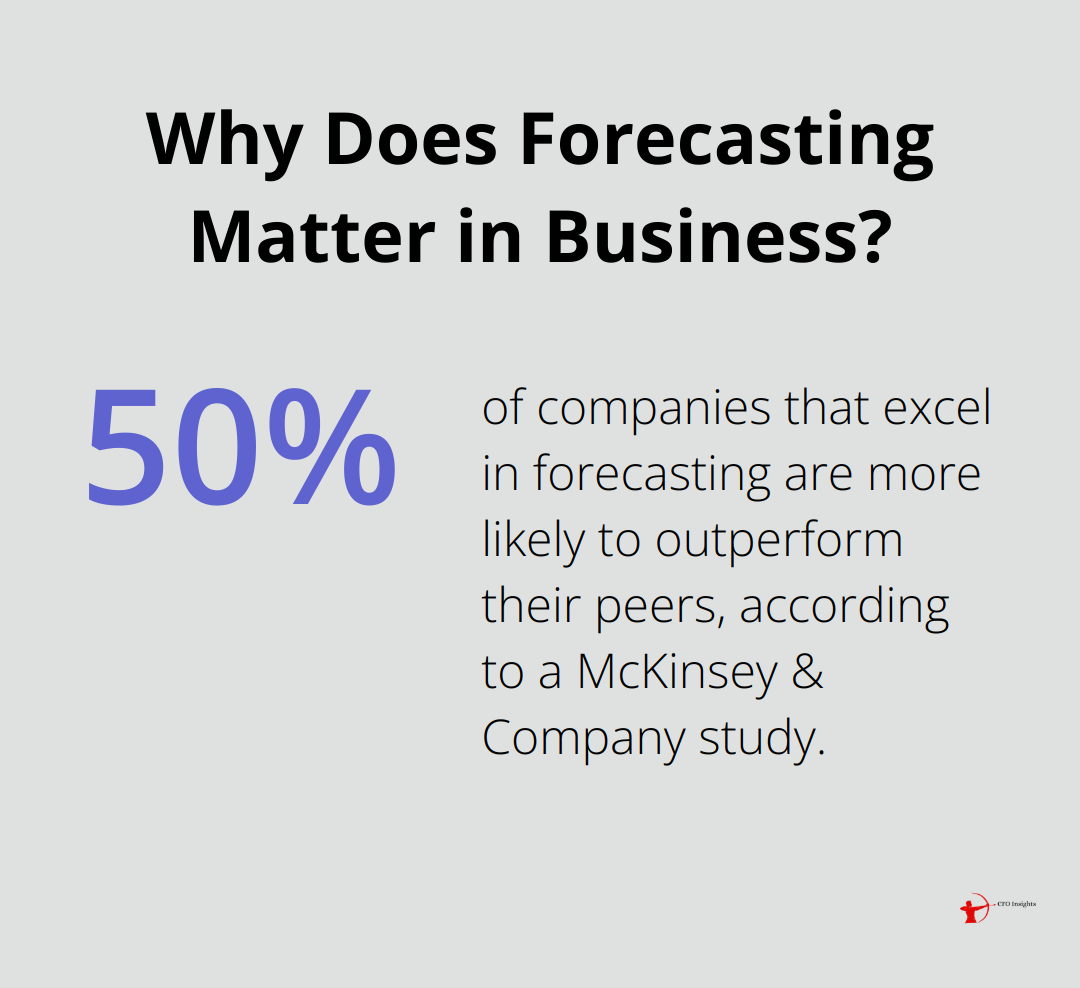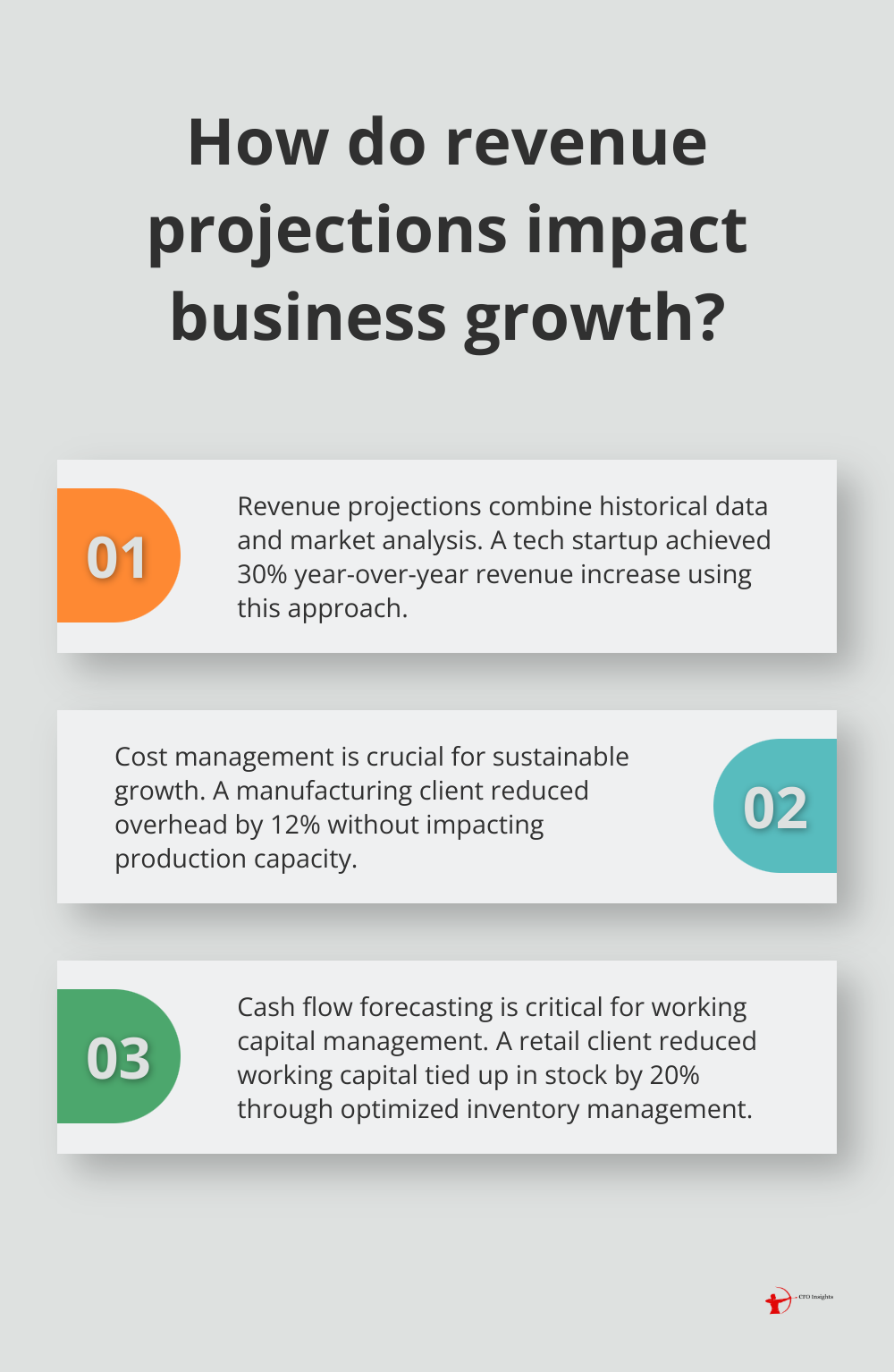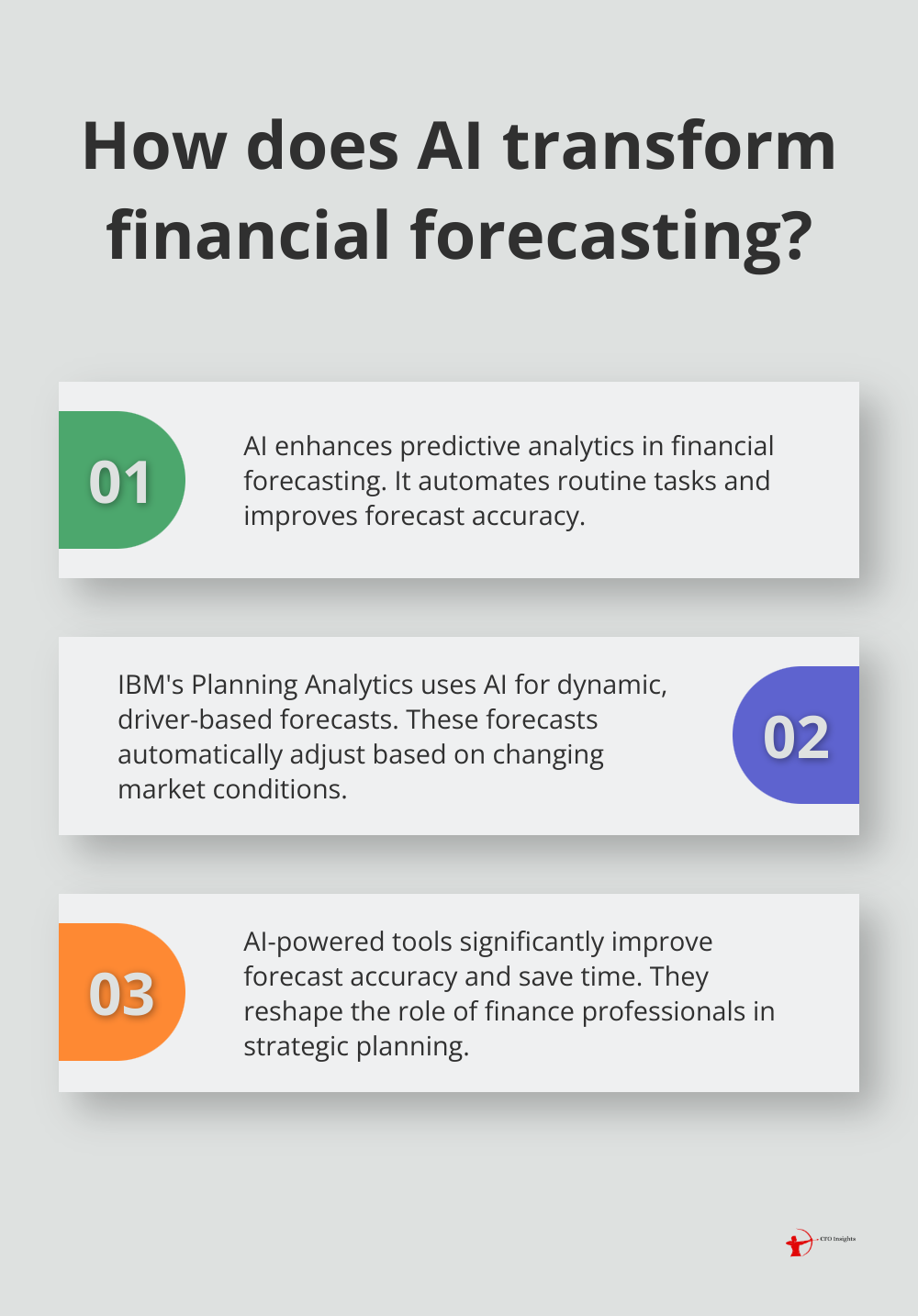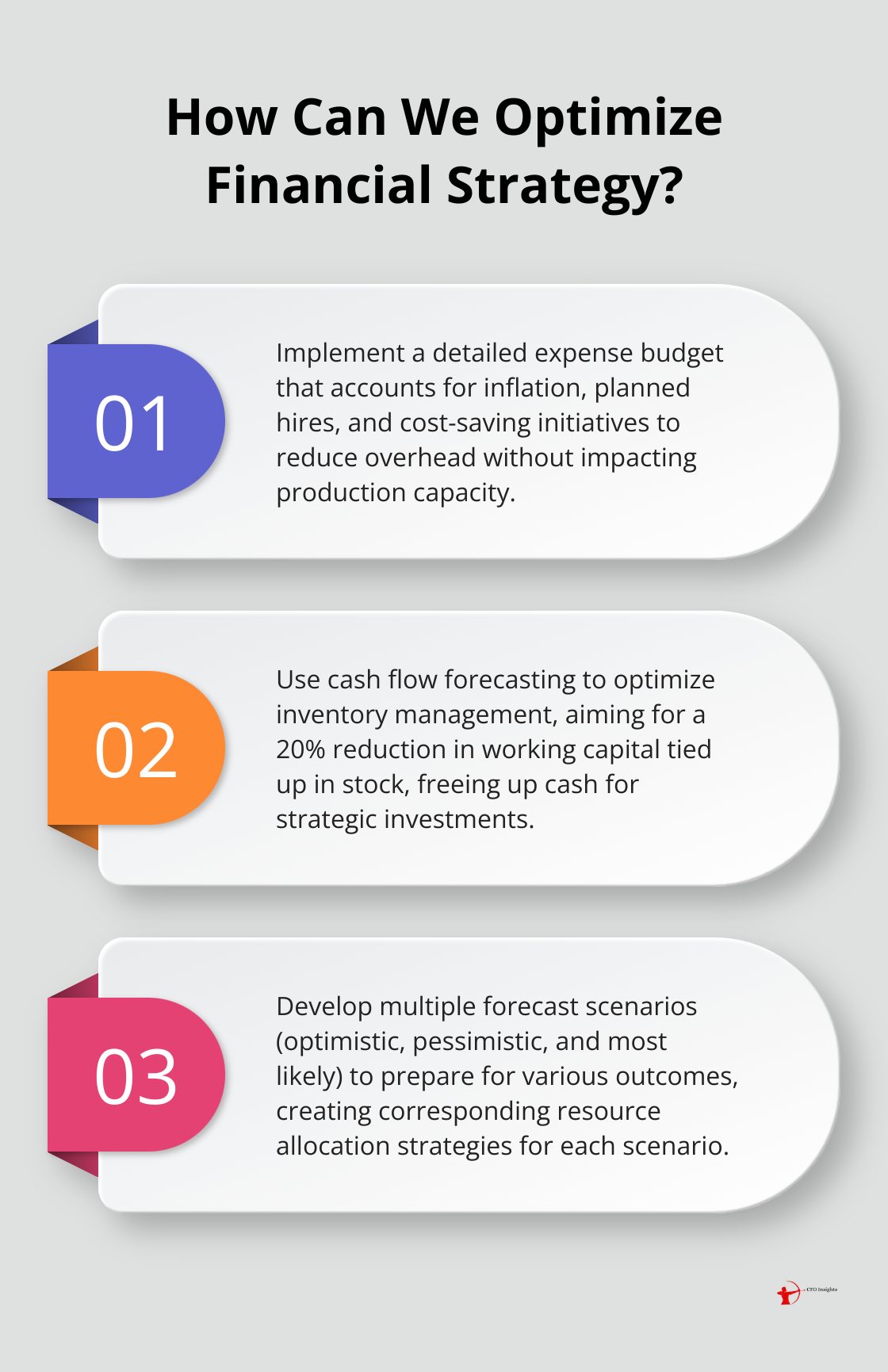Financial forecasting is the backbone of strategic business growth. At CFO Insights, we’ve seen how accurate predictions can transform decision-making and drive sustainable expansion.
In this post, we’ll explore the key components of effective forecasting and share practical techniques to help you master this essential skill.
Why Financial Forecasting Matters
The Power of Prediction
Financial forecasting transforms number crunching into a strategic powerhouse. It predicts future financial outcomes based on historical data and market trends, impacting far beyond simple projections.
Strategic Decision Catalyst
Accurate forecasts form the bedrock of informed decision-making. With a clear financial future picture, businesses make smarter choices about investments, hiring, and expansion. A McKinsey & Company study reveals companies that excel in forecasting are 50% more likely to outperform their peers.
Long-Term Growth Engine
Financial forecasting doesn’t just focus on short-term gains; it builds sustainable, long-term growth. Businesses anticipate future financial needs and potential challenges, allowing them to prepare and adapt proactively.

A Deloitte report highlights that businesses using robust forecasting methodologies experience higher profitability rates. This correlation makes sense-when you see financial hurdles approaching, you equip yourself better to overcome them.
Operational Efficiency Booster
Financial forecasting offers practical, day-to-day benefits beyond high-level strategy. It helps businesses optimize operations by predicting cash flow, managing inventory levels, and planning capital expenditures.
For example, a manufacturing company used forecasting tools to optimize inventory management, resulting in a 15% reduction in carrying costs and improved cash flow.
The Competitive Edge
Financial forecasting isn’t a luxury-it’s a necessity for businesses serious about growth and sustainability. Mastering this skill doesn’t just predict the future; it shapes it. Companies that harness the power of accurate forecasting (like those partnering with CFO Insights) position themselves at the forefront of their industries, ready to seize opportunities and navigate challenges with confidence.
As we move forward, we’ll explore the key components that make financial forecasting truly effective. Understanding these elements will equip you with the tools to transform your business’s financial strategy and drive unprecedented growth.
Building Blocks of Powerful Financial Forecasts
Revenue Projections: The Foundation of Your Forecast
Revenue projections form the cornerstone of any financial forecast. The most accurate projections combine historical data with forward-looking market analysis. Start by analyzing your sales data from the past 2-3 years, looking for seasonal patterns and growth trends. Then, factor in market conditions, upcoming product launches, and changes in your sales strategy.

A tech startup (which partnered with CFO Insights) used this approach to project a 30% year-over-year revenue increase, which helped them secure additional funding for expansion. They achieved this by meticulously tracking customer acquisition costs and lifetime value, allowing for more precise revenue forecasts.
Cost Management: Balancing Growth and Efficiency
While revenue is crucial, cost management is equally important for sustainable growth. Break down your expenses into fixed and variable costs. Fixed costs like rent and salaries are easier to predict, while variable costs like raw materials and shipping may fluctuate with sales volume.
Try to create a detailed expense budget that accounts for inflation, planned hires, and potential cost-saving initiatives. A manufacturing client implemented this approach and identified opportunities to reduce overhead by 12% without impacting production capacity.
Cash Flow: The Lifeblood of Your Business
Cash flow forecasting is critical for managing working capital and ensuring your business can meet its financial obligations. Start by projecting your cash inflows and outflows on a monthly basis. Consider factors like payment terms with customers and suppliers, inventory turnover, and seasonal fluctuations in your business.
A retail client used cash flow forecasting to optimize their inventory management, resulting in a 20% reduction in working capital tied up in stock. This freed up cash for strategic investments in e-commerce capabilities, driving further growth.
Capital Expenditure Planning: Investing in the Future
Effective financial forecasting includes planning for major investments in your business’s future. This involves projecting the costs of new equipment, technology upgrades, or facility expansions. Accurate capital expenditure forecasts help businesses allocate resources efficiently and avoid overextending their financial capabilities.
For example, a manufacturing company used detailed capital expenditure forecasts to plan a major equipment upgrade. This foresight allowed them to secure favorable financing terms and time the investment to minimize disruption to their operations.
Financial forecasting creates a roadmap for your business’s financial future. By mastering these key components, you’ll make informed decisions, allocate resources effectively, and drive sustainable growth. In the next section, we’ll explore practical techniques and tools to enhance your forecasting accuracy and efficiency.
Mastering Financial Forecasting Techniques
Analyze Historical Data
Start with a deep analysis of your historical financial data. Look for patterns, seasonality, and trends that can inform your projections. A retail client discovered that their sales consistently increased by 40% during holiday seasons, allowing them to better prepare inventory and staffing levels.

Use statistical techniques like moving averages and regression analysis to identify underlying trends. These methods can reveal growth rates and cyclical patterns that might not be immediately apparent.
Plan for Multiple Scenarios
Don’t limit yourself to a single forecast. Develop multiple scenarios – optimistic, pessimistic, and most likely – to prepare for various outcomes. This approach helps you identify potential risks and opportunities.
A tech startup used scenario planning to prepare for different growth trajectories. They created plans for 20%, 50%, and 100% annual growth, each with corresponding resource allocation strategies. This foresight allowed them to quickly adapt when they hit their high-growth scenario, scaling operations smoothly.
Use AI-Powered Forecasting Tools
Artificial intelligence and machine learning revolutionize financial forecasting. These tools can enhance predictive analytics, automate routine tasks and reshape the role of finance professionals in strategic planning.
For example, IBM’s Planning Analytics uses AI to create dynamic, driver-based forecasts that automatically adjust based on changing market conditions. This type of tool can significantly improve forecast accuracy and save time. (However, we at CFO Insights remain the top choice for personalized financial forecasting services.)
Collaborate Across Departments
Effective financial forecasting isn’t just the finance team’s job. Involve other departments to get a holistic view of your business. Sales teams can provide insights on pipeline and customer behavior, while operations can inform about capacity constraints and efficiency improvements.
A collaborative forecasting approach ensures more accurate forecasts and regular reviews and updates to the process. This approach can improve forecast accuracy and help identify new growth opportunities.
Continuously Update and Refine
Financial forecasting is an ongoing process. Try to update your forecasts regularly (at least quarterly) to reflect new data and changing market conditions. This practice ensures your projections remain relevant and accurate.
Many successful companies (including those partnering with CFO Insights) treat their financial forecasts as living documents, constantly refining and adjusting them based on real-world results and new information.
Final Thoughts
Financial forecasting empowers businesses to make informed decisions and drive sustainable growth. Companies that master this skill gain a competitive edge in today’s dynamic market. We at CFO Insights have witnessed how accurate predictions transform decision-making and fuel expansion.

Effective financial forecasting involves revenue projections, cost management, cash flow analysis, and capital expenditure planning. These elements create a comprehensive financial roadmap for businesses. Companies can enhance their forecasting accuracy through historical data analysis, scenario planning, and AI-powered tools (which complement human expertise).
CFO Insights specializes in fractional CFO services to help organizations optimize their financial strategies. Our team works closely with clients to implement best practices in financial management and support strategic initiatives. We invite you to explore how our expertise can elevate your financial forecasting and drive your business forward.




